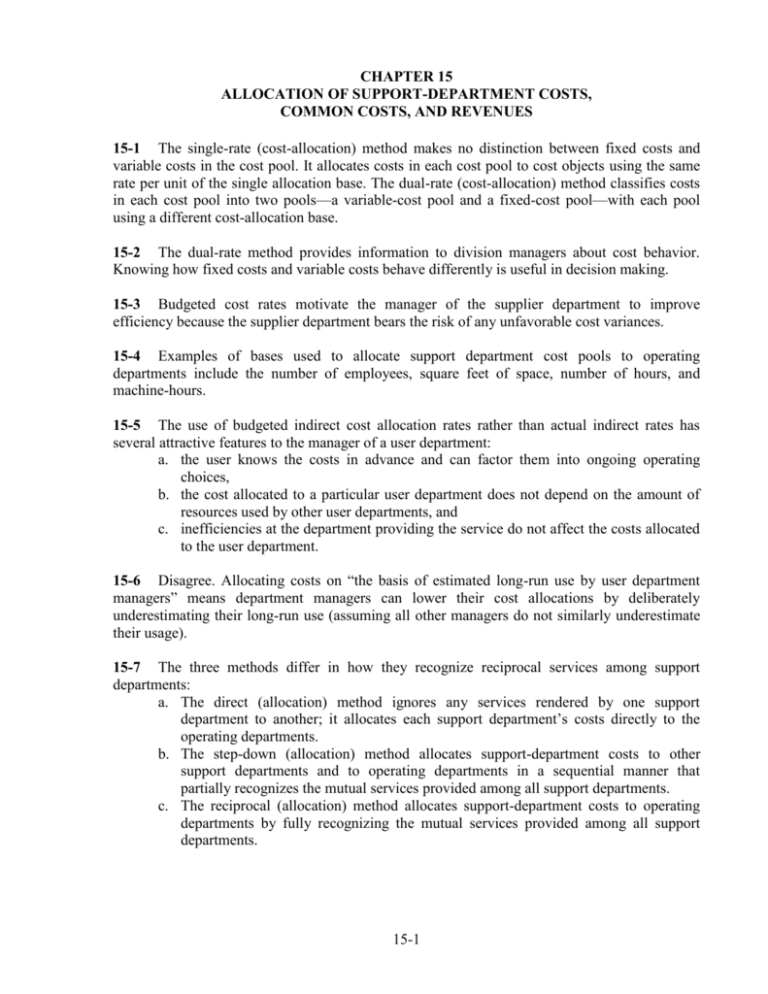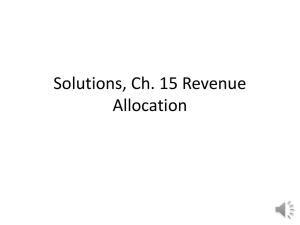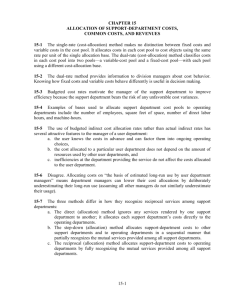CHAPTER 15
advertisement

CHAPTER 15 ALLOCATION OF SUPPORT-DEPARTMENT COSTS, COMMON COSTS, AND REVENUES 15-1 The single-rate (cost-allocation) method makes no distinction between fixed costs and variable costs in the cost pool. It allocates costs in each cost pool to cost objects using the same rate per unit of the single allocation base. The dual-rate (cost-allocation) method classifies costs in each cost pool into two pools—a variable-cost pool and a fixed-cost pool—with each pool using a different cost-allocation base. 15-2 The dual-rate method provides information to division managers about cost behavior. Knowing how fixed costs and variable costs behave differently is useful in decision making. 15-3 Budgeted cost rates motivate the manager of the supplier department to improve efficiency because the supplier department bears the risk of any unfavorable cost variances. 15-4 Examples of bases used to allocate support department cost pools to operating departments include the number of employees, square feet of space, number of hours, and machine-hours. 15-5 The use of budgeted indirect cost allocation rates rather than actual indirect rates has several attractive features to the manager of a user department: a. the user knows the costs in advance and can factor them into ongoing operating choices, b. the cost allocated to a particular user department does not depend on the amount of resources used by other user departments, and c. inefficiencies at the department providing the service do not affect the costs allocated to the user department. 15-6 Disagree. Allocating costs on “the basis of estimated long-run use by user department managers” means department managers can lower their cost allocations by deliberately underestimating their long-run use (assuming all other managers do not similarly underestimate their usage). 15-7 The three methods differ in how they recognize reciprocal services among support departments: a. The direct (allocation) method ignores any services rendered by one support department to another; it allocates each support department’s costs directly to the operating departments. b. The step-down (allocation) method allocates support-department costs to other support departments and to operating departments in a sequential manner that partially recognizes the mutual services provided among all support departments. c. The reciprocal (allocation) method allocates support-department costs to operating departments by fully recognizing the mutual services provided among all support departments. 15-1 15-8 The reciprocal method is theoretically the most defensible method because it fully recognizes the mutual services provided among all departments, irrespective of whether those departments are operating or support departments. 15-9 The stand-alone cost-allocation method uses information pertaining to each user of a cost object as a separate entity to determine the cost-allocation weights. The incremental cost-allocation method ranks the individual users of a cost object in the order of users most responsible for the common costs and then uses this ranking to allocate costs among those users. The first-ranked user of the cost object is the primary user and is allocated costs up to the costs of the primary user as a stand-alone user. The second-ranked user is the first incremental user and is allocated the additional cost that arises from two users instead of only the primary user. The third-ranked user is the second incremental user and is allocated the additional cost that arises from three users instead of two users, and so on. The Shapley Value method calculates an average cost based on the costs allocated to each user as first the primary user, the second-ranked user, the third-ranked user, and so on. 15-10 All contracts with U.S. government agencies must comply with cost accounting standards issued by the Cost Accounting Standards Board (CASB). 15-11 Areas of dispute between contracting parties can be reduced by making the “rules of the game” explicit and in writing at the time the contract is signed. 15-12 Companies increasingly are selling packages of products or services for a single price. Revenue allocation is required when managers in charge of developing or marketing individual products in a bundle are evaluated using product-specific revenues. 15-13 The stand-alone revenue-allocation method uses product-specific information on the products in the bundle as weights for allocating the bundled revenues to the individual products. The incremental revenue allocation method ranks individual products in a bundle according to criteria determined by management—such as the product in the bundle with the most sales—and then uses this ranking to allocate bundled revenues to the individual products. The first-ranked product is the primary product in the bundle. The second-ranked product is the first incremental product, the third-ranked product is the second incremental product, and so on. 15-14 Managers typically will argue that their individual product is the prime reason why consumers buy a bundle of products. Evidence on this argument could come from the sales of the products when sold as individual products. Other pieces of evidence include surveys of users of each product and surveys of people who purchase the bundle of products. 15-15 A dispute over allocation of revenues of a bundled product could be resolved by (a) having an agreement that outlines the preferred method in the case of a dispute, or (b) having a third party (such as the company president or an independent arbitrator) make a decision. 15-2 15-3 15-18 (20 min.) Dual-rate method, budgeted versus actual costs, and practical capacity versus actual quantities (continuation of 15-17). 1. Charges with dual rate method. Variable indirect cost rate = $1,500 per trip Fixed indirect cost rate = = $40,000 budgeted costs/ 50 round trips budgeted $800 per trip Dark Chocolate Division Variable indirect costs, $1,500 × 30 Fixed indirect costs, $800 × 30 Milk Chocolate Division Variable indirect costs, $1,500 × 15 Fixed indirect costs, $800 × 20 $45,000 24,000 $69,000 $22,500 16,000 $38,500 2. The dual rate changes how the fixed indirect cost component is treated. By using budgeted trips made, the Dark Chocolate Division is unaffected by changes from its own budgeted usage or that of other divisions. When budgeted rates and actual trips are used for allocation (see requirement 1.b. of problem 15-17), the Dark Chocolate Division is assigned the same $24,000 for fixed costs as under the dual-rate method because it made the same number of trips as budgeted. However, note that the Milk Chocolate Division is allocated $16,000 in fixed trucking costs under the dual-rate system, compared to $800 15 actual trips = $12,000 when actual trips are used for allocation. As such, the Dark Chocolate Division is not made to appear disproportionately more expensive than the Milk Chocolate Division simply because the latter did not make the number of trips it budgeted at the start of the year. 15-4 15-20 (50 min.) Support-department cost allocation, reciprocal method (continuation of 15-19). 1a. Costs Alloc. of AS costs (0.25, 0.40, 0.35) Alloc. of IS costs (0.10, 0.30, 0.60) Support Departments AS IS $600,000 $2,400,000 Operating Departments Govt. Corp. (861,538) 215,385 $ 344,615 $ 301,538 261,538 $ 0 (2,615,385) $ 0 784,616 $1,129,231 1,569,231 $1,870,769 Reciprocal Method Computation AS = $600,000 + 0.10 IS IS = $2,400,000 + 0.25AS IS = $2,400,000 + 0.25 ($600,000 + 0.10 IS) = $2,400,000 + $150,000 + 0.025 IS 0.975IS = $2,550,000 IS = $2,550,000 ÷ 0.975 = $2,615,385 AS = $600,000 + 0.10 ($2,615,385) = $600,000 + $261,538 = $861,538 1b. Costs 1st Allocation of AS (0.25, 0.40, 0.35) 1st Allocation of IS (0.10, 0.30, 0.60) 2nd Allocation of AS (0.25, 0.40, 0.35) 2nd Allocation of IS (0.10, 0.30, 0.60) 3rd Allocation of AS (0.25, 0.40, 0.35) 3rd Allocation of IS (0.10, 0.30, 0.60) th 4 Allocation of AS Support Departments AS IS $600,000 $2,400,000 (600,000) 150,000 2,550,000 255,000 (2,550,000) Operating Departments Govt. Corp. $ 240,000 $ 210,000 765,000 1,530,000 63,750 102,000 89,250 6,375 (63,750) 19,125 38,250 (6,375) 1,594 2,550 2,231 160 (1,594) 478 956 (255,000) 15-5 (0.25, 0.40, 0.35) 4th Allocation of IS (0.10, 0.30, 0.60) 5th Allocation of AS (0.25, 0.40, 0.35) 5th Allocation of IS (0.10, 0.30, 0.60) Total allocation (160) $ 40 64 56 4 (40) 12 24 (4) 1 2 1 0 0 (1) 0 0 $1,129,231 1 $1,870,769 $ 2. a. b. c. d. e. Direct Step-Down (AS first) Step-Down (IS first) Reciprocal (linear equations) Reciprocal (repeated iterations) Govt. Consulting $1,120,000 1,090,000 1,168,000 1,129,231 1,129,231 Corp. Consulting $1,880,000 1,910,000 1,832,080 1,870,769 1,870,769 The four methods differ in the level of support department cost allocation across support departments. The level of reciprocal service by support departments is material. Administrative Services supplies 25% of its services to Information Systems. Information Systems supplies 10% of its services to Administrative Services. The Information Department has a budget of $2,400,000 that is 400% higher than Administrative Services. The reciprocal method recognizes all the interactions and is thus the most accurate. This is especially clear from looking at the repeated iterations calculations. 15-6 15-22 (30 min.) Reciprocal cost allocation (continuation of 15-21). 1. The reciprocal allocation method explicitly includes the mutual services provided among all support departments. Interdepartmental relationships are fully incorporated into the support department cost allocations. 2. HR = $72,700 + .08333IS IS = $234,400 + .23077HR HR = $72,700 + [.08333($234,400 + .23077HR)] = $72,700 + [$19,532.55 + 0.01923HR] 0.98077HR = $92,232.55 HR = $92,232.55 0.98077 = $94,041 IS = $234,400 + (0.23077 $94,041) = $256,102 Costs Incurred Alloc. of HR costs (21/91, 42/91, 28/91) Support Depts. HR Info. Systems $72,700 $234,400 (94,041) Alloc. of Info. Syst. costs (320/3,840, 1,920/3,840, 1,600/3,840) 21,341 0 $ 21,702 (256,102) $ 0 Operating Depts. Corporate Consumer $ 998,270 $489,860 43,404 28,935 128,051 $1,169,725 106,710 $625,505 Solution Exhibit 15-22 presents the reciprocal method using repeated iterations. 15-7 Total $1,795,230 $1,795,230 SOLUTION EXHIBIT 15-22 Reciprocal Method of Allocating Support Department Costs for September 2009 at E-books Using Repeated Iterations Support Departments Operating Departments Information Corporate Consumer Human Resources Systems Sales Sales Budgeted manufacturing overhead costs before any interdepartmental cost allocation $234,400 $ 998,270 $489,860 (72,700) 16,777 251,177 33,554 22,369 1st Allocation of Information Systems (320/3,840, 1,920/3,840, 1,600/3,840)b 20,931 (251,177) 125,589 104,657 2nd Allocation of HR (21/91, 42/91, 28/91)a (20,931) 4,830 9,661 6,440 (4,830) 2,415 2,013 93 185 124 1st Allocation of HR (21/91, 42/91, 28/91)a $72,700 2nd Allocation of Information Systems (320/3,840, 1,920/3,840, 1,600/3,840)b 402 3rd Allocation of HR (21/91, 42/91, 28/91)a (402) 3rd Allocation of Information Systems (320/3,840, 1,920/3,840, 1,600/3,840)b 8 (93) 46 39 4th Allocation of HR (21/91, 42/91, 28/91)a (8) 2 4 2 4th Allocation of Information Systems: (320/3,840, 1,920/3,840, 1,600/3,840)b 0 (2) 1 1 $1,169,725 $625,505 Total budgeted manufacturing overhead of operating departments $ 0 $ 0 Total $1,795,230 $1,795,230 Total accounts allocated and reallocated (the numbers in parentheses in first two columns) HR $72,700 + $20,931 + $402 + $8 = $94,041 Information Systems $251,177 + $4,830 + $93 + $2 = $256,102 aBase bBase is (21 + 42 + 28) or 91 employees is (320 + 1,920 + 1,600) or 3,840 minutes 3. The reciprocal method is more accurate than the direct and step-down methods when there are reciprocal relationships among support departments. A summary of the alternatives is: Direct method Step-down method (HR first) Reciprocal method Corporate Sales $1,169,745 1,168,830 1,169,725 Consumer Sales $625,485 626,400 625,505 The reciprocal method is the preferred method, although for September 2009 the numbers do not appear materially different across the alternatives. 15-8 15-9 15-24 (20 min.) Allocation of common costs. 1. Alternative approaches for the allocation of the $1,800 airfare include the following: a. The stand-alone cost allocation method. This method would allocate the air fare on the basis of each client’s percentage of the total of the individual stand-alone costs. Baltimore client $1, 400 $1,800 = $1,008 $1, 400 $1,100 Chicago client $1,100 $1,800 = $1, 400 $1,100 792 $1,800 Advocates of this method often emphasize an equity or fairness rationale. b. The incremental cost allocation method. This requires the choice of a primary party and an incremental party. If the Baltimore client is the primary party, the allocation would be: Baltimore client Chicago client $1,400 400 $1,800 One rationale is that Gunn was planning to make the Baltimore trip, and the Chicago stop was added subsequently. Some students have suggested allocating as much as possible to the Baltimore client since Gunn had decided not to work for them. If the Chicago client is the primary party, the allocation would be: Chicago client Baltimore client $1,100 700 $1,800 One rationale is that the Chicago client is the one who is going to use Gunn’s services, and presumably receives more benefits from the travel expenditures. c. Gunn could calculate the Shapley value that considers each client in turn as the primary party: The Baltimore client is allocated $1,400 as the primary party and $700 as the incremental party for an average of ($1,400 + $700) ÷ 2 = $1,050. The Chicago client is allocated $1,100 as the primary party and $400 as the incremental party for an average of ($1,100 + 400) ÷ 2 = $750. The Shapley value approach would allocate $1,050 to the Baltimore client and $750 to the Chicago client. 15-10 2. I would recommend Gunn use the Shapley value. It is fairer than the incremental method because it avoids considering one party as the primary party and allocating more of the common costs to that party. It also avoids disputes about who is the primary party. It allocates costs in a manner that is close to the costs allocated under the stand-alone method but takes a more comprehensive view of the common cost allocation problem by considering primary and incremental users, which the stand-alone method ignores. The Shapley value (or the stand-alone cost allocation method) would be the preferred methods if Gunn was to send the travel expenses to the Baltimore and Chicago clients before deciding which engagement to accept. Other factors such as whether to charge the Chicago client more because Gunn is accepting the Chicago engagement or the Baltimore client more because Gunn is not going to work for them can be considered if Gunn sends in her travel expenses after making her decision. However, each company would not want to be considered as the primary party and so is likely to object to these arguments. 3. A simple approach is to split the $60 equally between the two clients. The limousine costs at the Sacramento end are not a function of distance traveled on the plane. An alternative approach is to add the $60 to the $1,800 and repeat requirement 1: a. Stand-alone cost allocation method. $1, 460 Baltimore client $1,860 = $1,036 $1, 460 $1,160 $1,160 Chicago client $1,860 = $ 824 $1, 460 $1,160 b. Incremental cost allocation method. With Baltimore client as the primary party: Baltimore client $1,460 Chicago client 400 $1,860 With Chicago client as the primary party: Chicago client $1,160 Baltimore client 700 $1,860 c. Shapley value. Baltimore client: Chicago client: ($1,460 + $700) ÷ 2 = $1,080 ($400 + $1,160) ÷ 2 = $ 780 As discussed in requirement 2, the Shapley value or the stand-alone cost allocation method would probably be the preferred approaches. Note: If any students in the class have faced this situation when visiting prospective employers, ask them how they handled it. 15-11 15-26 (10-15 min. ) Allocation of Common Costs 1. a. Stand-alone method (costs are in thousands): City Albany Troy Schenectady Separate Cost $2,100 1,400 3,500 $7,000 Percentage $2,100 ÷ $7,000=0.3 $1,400 ÷ $7,000=0.2 $3,500 ÷ $7,000=0.5 Joint Cost $5,000 5,000 5,000 Allocation $1,500 1,000 2,500 $5,000 1. b. Incremental method (cities ranked in order of most waste to least waste): Schenectady Albany Troy Allocated Cost $3,500 1,500 0 Cost Remaining to Allocate $1,500 ($5,000 ─ $3,500) 0 ($1,500 ─ $1,500) 0 2. In this situation, the stand-alone method is the better method because the weights it uses for allocation are based on the cost for each user as a separate entity. The citizens of Schenectady would not consider the incremental method fair because they would be subsidizing the other cities (especially Troy). Albany is indifferent across the two methods; its citizens save $600,000 over the stand-alone cost in either case. While the citizens of Troy would clearly prefer the incremental allocation method and might seek to justify it because they generate the least amount of waste, they should understand that citizens of the other cities would believe it is not fair. 15-12 15-13 15-28 (20 min.) Revenue allocation 1. a. Stand-alone method for the BegM + RCC package DVD BegM RCC Separate Revenue $ 60 40 $100 Joint Percentage Revenue $60 ÷ $100=0.6 $90 $40 ÷ $100=0.4 90 Allocation $54 36 $90 1. b. Incremental method i) BegM RCC Allocated Revenue (BegM first) $60 30 Revenue Remaining To Allocate $30 ($90 ─ $60) RCC BegM Allocated Revenue (RCC first) $40 50 Revenue Remaining To Allocate $50 ($90 ─ $40) ii) 1. c. Shapley method. (assuming each DVD is demanded in equal proportion) i) BegM ii) RCC ($60 + $50) ÷ 2 = $55 ($30 + $40) ÷ 2 = $35 2. a. Stand-alone method for the ConM + RCC package DVD ConM RCC Separate Revenue $50 40 $90 Joint Percentage Revenue $50 ÷ $90=0.556 $72 $40 ÷ $90=0.444 72 2. b. Incremental method i) ConM RCC Allocated Revenue (ConM first) $50 22 Revenue Remaining To Allocate $22 ($72 ─ $50) RCC ConM Allocated Revenue (RCC first) $40 32 Revenue Remaining To Allocate $32 ($72 ─ $40) ii) 15-14 Allocation $40 32 $72 2. c. Shapley method. (assuming each DVD is demanded in equal proportion) i) BegM ii) RCC 3. (50+32) ÷ 2 = 41 (22+40) ÷ 2 = 31 For each DVD package, the stand-alone method and the Shapley method give approximately the same allocation to each DVD. These methods are fair if the demand for the DVDs are approximately equal. The stand-alone method might be slightly preferable here since it is simpler and easier to explain. The incremental method would be appropriate if one DVD has a higher level of demand than the other DVD. In this situation, the dominant DVD would be sold anyway so it should receive its stand-alone revenue, and the other DVD should receive the remainder. 15-15 15-16 15-30 (45 min.) Allocating costs of support departments; step-down and direct methods. 1. Step-down Method: (1) Building & grounds at $0.10/sq.ft. ($10,000 ÷ 100,000) (2) Personnel at $6/employee ($1,200 ÷ 200) (3) General plant administration at $1/labor-hour ($27,000 ÷ 27,000) (4) Cafeteria at $20/empoloyee ($3,100 ÷ 155) (5) Storeroom at $1.50/requisition ($4,500 ÷ 3,000) (6) Costs allocated to operating depts. (7) Divide (6) by dir. manuf. labor-hrs. (8) Overhead rate per direct manuf. labor-hour 2. Direct method: (1) Building & grounds, 30,000/80,000; 50,000/80,000 (2) Personnel, 50/150; 100/150 (3) General plant administration, 8,000/25,000; 17,000/25,000 (4) Cafeteria, 50/150; 100/150 (5) Storeroom: 2,000/3,000; 1,000/3,000 (6) Costs allocated to operating depts. (7) Divide (6) by direct manufacturing labor-hours (8) Overhead rate per direct manufacturing labor-hour Building & Grounds $ 10,000 $(10,000) Personnel $ 1,000 General Plant Admin. $ 26,090 Cafeteria Operating Loss $ 1,640 200 700 400 210 $(1,200) $(27,000) Machining $34,700 Assembly $48,900 700 3,000 5,000 60 30 300 600 1,000 1,000 8,000 17,000 100 1,000 2,000 3,000 $50,000 ÷ 5,000 1,500 $75,000 ÷15,000 $ $ $(3,100) Storeroom $ 2,670 $(4,500) $10,000 $1,000 $26,090 $1,640 $2,670 (10,000) (1,000) (26,090) (1,640) (2,670) 15-17 10 5 $34,700 $48,900 3,750 333 6,250 667 8,349 547 17,741 1,093 1,780 $49,459 890 $75,541 ÷ 5,000 ÷15,000 $ 9.892 $ 5.036 3. Comparison of Methods: Step-down method: Job 88: Job 89: Direct method: Job 88: Job 89: 18 × $10 2×$ 5 3 × $10 17 × $ 5 18 × $9.892 2 × $5.036 3 × $9.892 17 × $5.036 $180 10 $ 30 85 $178.06 10.07 $ 29.68 85.61 $190.00 115.00 $188.13 115.29 4. The manager of Machining Department would prefer the direct method. The direct method results in a lower amount of support departments’ costs being allocated to the Machining Department than the step-down method. This is clear from a comparison of the overhead rate, per direct manufacturing labor-hour, for the Machining Department under the two methods. 15-18 15-19 15-32 (25 min.) Common costs. 1. Stand-alone cost-allocation method. Wright, Inc. Brown, Inc. 2. = (900 $40) (1,500 $32) (900 $40) (600 $40) = $36, 000 $48, 000 = $28,800 ($36, 000 $24, 000) = (600 $40) (1,500 $32) (900 $40) (600 $40) = $24, 000 $48, 000 = $19,200 ($36, 000 $24, 000) With Wright, Inc. as the primary party: Party Wright Brown Total Costs Allocated $36,000 12,000 ($48,000 – $36,000) $48,000 Cumulative Costs Allocated $36,000 $48,000 With Brown, Inc. as the primary party: Party Brown Wright Total Costs Allocated $24,000 24,000 ($48,000 – $24,000) $48,000 15-20 Cumulative Costs Allocated $24,000 $48,000 3. To use the Shapley value method, consider each party as first the primary party and then the incremental party. Compute the average of the two to determine the allocation. Wright, Inc.: Allocation as the primary party Allocation as the incremental party Total Allocation ($60,000 ÷ 2) $36,000 24,000 $60,000 $30,000 Brown, Inc.: Allocation as the primary party Allocation as the incremental party Total Allocation ($36,000 ÷ 2) $24,000 12,000 $36,000 $18,000 Using this approach, Wright, Inc. is allocated $30,000 and Brown, Inc. is allocated $18,000 of the total costs of $48,000. 4. The results of the four cost-allocation methods are shown below. Stand-alone method Incremental (Wright primary) Incremental (Brown primary) Shapley value Wright, Inc. $28,800 36,000 24,000 30,000 Brown, Inc. $19,200 12,000 24,000 18,000 The allocations are very sensitive to the method used. The stand-alone method is simple and fair since it allocates the common cost of the dyeing machine in proportion to the individual costs of leasing the machine. The Shapley values are also fair. They result in very similar allocations and any one of them can be chosen. In this case, the stand-alone method is likely more acceptable. If they used the incremental cost-allocation method, Wright, Inc. and Brown, Inc. would probably have disputes over who is the primary party because the primary party gets allocated all of the primary party’s costs. 15-21 15-22 15-34 (10-15 min.) Effect of demand (continuation of 15-33) 1. If the Water park receives its full ticket price of $40, then the remaining proceeds from the sale of the three day ticket, $90 – 40 = $50, would be divided between the two remaining parks. Using ticket price as the basis of allocation, each park would receive: Park Superhero Theme Animal Total Ticket Price $60 20 $80 Percentage of Total Price 0.750 0.250 Allocation % × $50 $37.50 12.50 $50.00 The same process would be used for the other two allocation bases. Under the cost basis, the 25 Superhero Theme park receives 25+10 ×$50 = $35.71, while Animal park gets the other $14.29. If revenue is assigned based on the number of tickets received, then the Superhero Theme and Animal Parks would each receive $25. 2. If the Superhero Theme park also demanded its full ticket price then it would want to receive $60. The two parks, Water and Superhero Theme, would then receive a combined amount of $40 + 60 = $100. Since the three-day ticket sells for only $90, this would not be possible. In addition, the Animal park director would not be pleased because he would incur a $10 cost for each entrant but receive no proceeds from the ticket. 3. If both the Water and the Superhero Theme parks are really operating at capacity then Funland is losing money by selling the three-day ticket for $90. Kent Clark should either raise the price or decide not to sell the three-day ticket. Alternatively, if he wishes to persist with the current arrangement, he should use a more sophisticated arrangement for allocating revenue, such as the Shapley method or even the weighted Shapley method. In the latter case, Kent could assign the number of months each park is considered the primary park as the weighting scheme. For example, while the Water Park may drive sales of the three-day ticket during summer months, customers may be more interested in one of the other parks during cooler periods. 15-23 15-24







